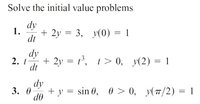There are two distinctly different kinds of differential equations.
A differential equation where all additional conditions at the same value of the independent variable, for example, y(a), y'(a),etc. are given, then the "fundamental existence and uniqueness theorem" says that the existence of a solution depends only on the differential equation. Those are "initial value problems" (so called because many applications have time, t, as independent variable and initial values at t= 0.
The initial value problem, \(\displaystyle \frac{d^2y}{dx^2}+ y= 0\), y(a)= P, y(a)= Q has a unique solution no matter what a, P, and Q are.
A "boundary value problem", on the other hand, has additional data, function values, derivative values, etc. at two or more different points. And whether of not a solution exists can depend on that additional data as well as the equation.
For example, \(\displaystyle \frac{d^2 y}{dx^2}+ y= 0\), y(0)= 0, \(\displaystyle y(\pi/2)= 1\) has a unique solutio, \(\displaystyle y= cos(x)\) but \(\displaystyle \frac{d^2 y}{dx^2}+ y= 0\), y(0)= 0, \(\displaystyle y(\pi)= 1\) has no solution while \(\displaystyle \frac{d^2 y}{dx^2}+ y= 0\), y(0)= 0, \(\displaystyle y(\pi)= 0\) has infinitely many solutions.


